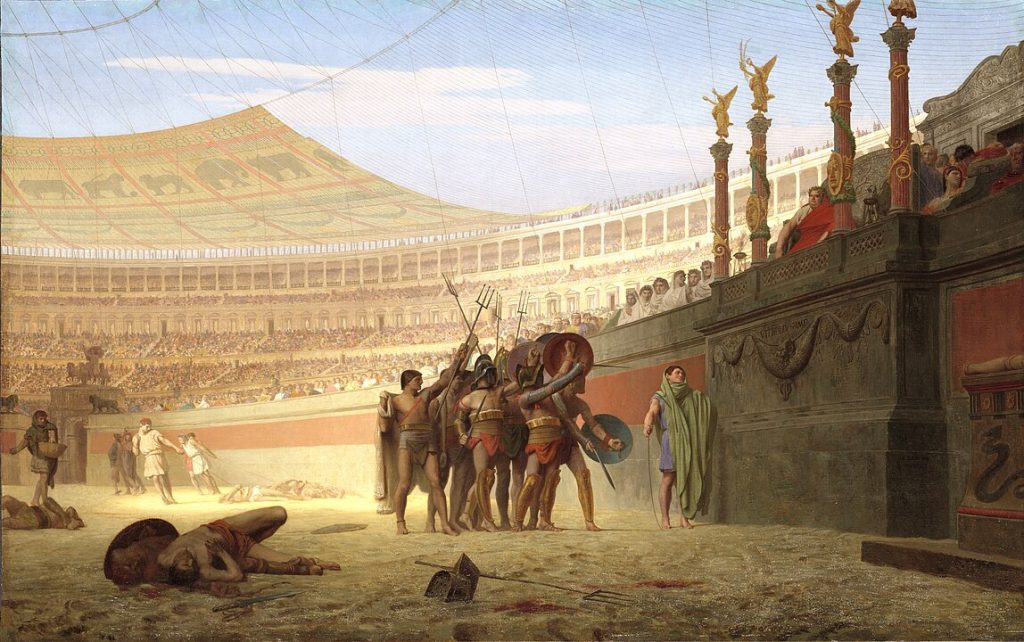
Rising proudly in the heart of modern Rome, the Colosseum is one of the most iconic and enduring symbols of ancient Roman civilization. This colossal amphitheater, originally known as the Flavian Amphitheater, was an unparalleled achievement of its time. Built nearly 2,000 years ago, it hosted grand spectacles that entertained and awed the Roman populace, serving as both a marvel of architecture and a powerful statement of imperial might. Today, the Colosseum stands as a globally recognized monument to Rome’s cultural and engineering legacy.
From gladiatorial combat to simulated naval battles, the Colosseum was designed to captivate audiences and glorify the empire. Commissioned during the reign of Emperor Vespasian, its construction was a response to political and social upheaval, intended to unify the people of Rome. By transforming land that once served as the site of Emperor Nero’s private estate into a public venue, the Flavian dynasty reinforced their connection to the Roman citizens.
Over the centuries, the Colosseum has weathered earthquakes, stone looting, and the test of time, yet it remains a beacon of history. Designated a UNESCO World Heritage Site, it attracts millions of visitors each year, offering a tangible connection to the splendor and complexities of ancient Rome. Through preservation efforts and modern tourism, the Colosseum continues to inspire awe and admiration.
A Historical Overview
The Colosseum was born during a transformative period in Roman history. Following the tumultuous rule of Emperor Nero, Rome craved stability and renewal. In A.D. 70, Emperor Vespasian initiated the construction of the Colosseum as part of his efforts to restore public trust in the empire. By offering the Roman people a grand venue for entertainment, he shifted focus from Nero’s personal excesses to communal celebration.
When the amphitheater was inaugurated by Emperor Titus in A.D. 80, it became an instant sensation. The inaugural games lasted 100 days, featuring gladiatorial contests, animal hunts, and theatrical reenactments of famous military victories. Spectators marveled as the arena transformed into a battleground, filled with exotic animals from across the empire, or into a stage for mock sea battles, with the floor flooded to mimic naval warfare. These events showcased Rome’s resources, engineering, and might.
The Colosseum was not just a venue for grand entertainment; it was also a symbol of political authority and unity. By offering free admission to games, emperors secured the loyalty of the Roman people and reinforced their power. Over time, however, as Rome’s influence waned and Christianity rose, the amphitheater’s role diminished. By the 6th century, it had ceased to host games, reflecting the empire’s broader cultural and religious shift.
Architectural Grandeur
The Colosseum’s design and construction are testaments to Roman ingenuity, blending practicality with monumental scale. Standing 50 meters (164 feet) tall and spanning 189 meters (615 feet) in length, the Colosseum was the largest amphitheater ever built. It incorporated innovative architectural techniques that allowed it to accommodate tens of thousands of spectators while remaining structurally sound.
One of its most impressive features was its system of arches and vaults, which distributed weight evenly and provided stability. The use of concrete—a Roman invention—allowed builders to create a massive, durable structure while saving on materials and time. The exterior’s three levels of arches, adorned with Tuscan, Ionic, and Corinthian columns, created a visually stunning facade that symbolized order and hierarchy.
The interior was equally sophisticated, featuring tiered seating that reflected Roman society. The closer one sat to the arena, the higher their status: senators and elites enjoyed prime seating, while ordinary citizens and women were relegated to the upper tiers. The hypogeum, an underground network of tunnels and chambers, added another layer of complexity. This system housed animals, gladiators, and stage machinery, enabling seamless transitions and dramatic surprises during events.
Cultural Significance
The Colosseum was more than an architectural masterpiece; it was a cultural epicenter where the Roman world came to life. Its spectacles were carefully curated to impress, entertain, and reinforce Rome’s dominance. Gladiatorial games, in particular, became a defining feature of Roman culture, blending violence with valor to celebrate the empire’s ideals.
Gladiators were the heroes of the Colosseum, though their lives were often harsh and short. Many were enslaved people, prisoners of war, or criminals, forced into combat as punishment or entertainment. However, some volunteered for the chance at fame and fortune, earning respect and adoration from the public. Their battles, often against fellow gladiators or wild animals, were seen as demonstrations of courage and endurance.
The Colosseum’s events also served as propaganda, emphasizing the emperor’s generosity and the empire’s wealth. Exotic animals—lions, elephants, and even crocodiles—were imported from far-flung provinces, showcasing Rome’s vast reach. Naval battles were staged with incredible engineering feats, flooding the arena to create artificial lakes. These spectacles reinforced the idea that Rome was not only powerful but also a unifying force capable of extraordinary achievements.
Modern Relevance
Today, the Colosseum is a bridge between past and present, drawing millions of visitors who marvel at its history and architecture. Its enduring appeal lies not only in its size and grandeur but also in the stories it tells. Each stone and arch speaks of a time when Rome ruled the known world, making it a powerful symbol of human achievement and ambition.
Preservation efforts have been vital in protecting the Colosseum from modern threats, including pollution, earthquakes, and urban development. Recent restorations have focused on stabilizing its structure and enhancing visitor experiences. For instance, parts of the hypogeum have been reopened to the public, offering a rare glimpse into the inner workings of this ancient marvel.
The Colosseum is also a cultural and educational hub, hosting exhibitions and events that delve into Roman history and archaeology. As a UNESCO World Heritage Site, it is celebrated not only as a relic of the past but also as an inspiration for future generations. Its enduring legacy reminds us of the creativity, resilience, and ambition that define human civilization.
Visiting the Colosseum
Visiting the Colosseum is an unforgettable experience, offering a glimpse into the grandeur of ancient Rome. Whether you’re exploring its towering arches or descending into the hypogeum, every corner of this monument holds a story. Guided tours are highly recommended, providing detailed insights into the Colosseum’s history, architecture, and cultural significance.
For a comprehensive experience, visitors can purchase combined tickets that include access to the Roman Forum and Palatine Hill, located nearby. These sites complement the Colosseum, showcasing the political and social heart of ancient Rome. Walking through these areas offers a deeper understanding of the empire’s daily life and monumental achievements.
Timing your visit is essential to avoid crowds and fully appreciate the Colosseum’s majesty. Early morning or late afternoon visits provide the best lighting and a more intimate experience. For an added touch of magic, consider an evening tour, where the Colosseum’s illuminated arches create a mesmerizing atmosphere.
Key Takeaways
- The Colosseum is an architectural and cultural masterpiece that symbolizes ancient Rome’s power and ingenuity.
- Constructed in A.D. 70–80, it hosted gladiatorial games, naval battles, and other spectacles to entertain and unite Roman citizens.
- Its innovative design, including the hypogeum and tiered seating, reflects Roman engineering prowess.
- Today, it is a UNESCO World Heritage Site and one of the world’s most visited landmarks, with ongoing preservation efforts ensuring its legacy.
- Visitors can explore the Colosseum alongside nearby historical sites, such as the Roman Forum and Palatine Hill, for a comprehensive view of ancient Rome.
FAQs
1. What was the Colosseum’s primary purpose?
It served as an amphitheater for public entertainment, including gladiatorial games, animal hunts, and mock naval battles.
2. How did the Colosseum reflect Roman society?
The tiered seating system mirrored Rome’s social hierarchy, with the elite occupying the best seats and lower classes relegated to higher tiers.
3. Why is the Colosseum significant today?
It is a symbol of Roman engineering and cultural achievements, attracting millions of visitors as a historical and architectural landmark.
4. What challenges does the Colosseum face today?
Modern threats include pollution, earthquakes, and urbanization, which require ongoing restoration and preservation efforts.
5. Can visitors explore all areas of the Colosseum?
Many areas, including the hypogeum and upper tiers, are accessible via guided tours, offering a closer look at its inner workings.




